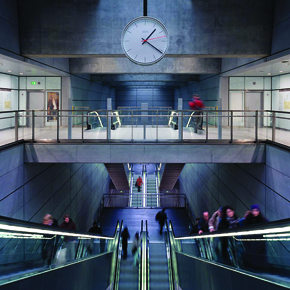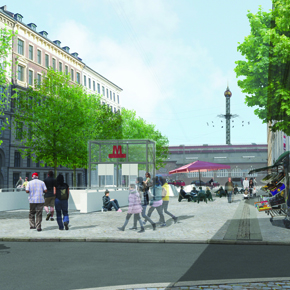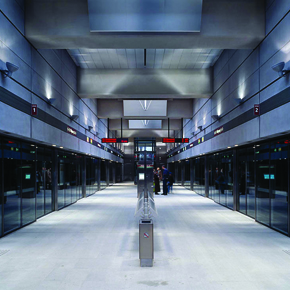
Re-thinking the commute: How design can improve the commuter experience
Nille Juul-Sorenson, global business leader for architecture at Arup, discusses how design can be harnessed to improve the commuter experience…
What is the most stressful part of your day? According to research, it is likely to be your commute, as studies indicate that people find getting to work even more stressful than the jobs they do.
Longer, heavily populated commutes are the natural result of a rapidly growing urban population. Add to this the unpredictable British weather, delays and congestion – and you have the ideal recipe for a fraught commuting experience.
Although it is true that a number of these factors are out of our hands, many of the frustrations felt by commuters are the bi-product of poor station design. Below are the most significant of these, and how they could – and are – being resolved through passenger-sensitive station design:
Claustrophobia
Claustrophobia – the fear of confined spaces – affects around 10% of the UK population and results in heightened stress and anxiety. Descending into confined spaces underground can cause feelings of claustrophobia, while artificial lighting can make navigating a metro network even more complex.
When we design a house or an office building, daylight is a primary consideration, however, this is rarely factored into the design of our transport systems. Introducing a whole new lighting scheme would be a big step in making commuters’ journeys more acceptable.
New York City’s Fulton Center, a subway station and shopping centre, and Copenhagen’s Cityringen, provide prime examples of how this can be achieved. Both use a combination of skylights and reflective materials to direct sunlight into the stations below. In Copenhagen these systems enable natural light to permeate 20m below ground level.
Ticket barriers
Even when you make it through the gates first time, the experience of moving through any ticketed area or barrier makes you acutely aware that you’re transitioning to a different, monitored environment – which is stressful in itself.
In the near future, we’ll see technology resolve this problem, with systems that automatically register and charge passengers as they enter trains. This will reduce station congestion and make the passenger experience one of smooth continuity – right from the station to the train.
Unintentional encounters
Whether it is spotting the least crowded carriage or avoiding a boisterous group on their way to a party, poor visibility on public transport can lead to commuters unintentionally entering into uncomfortable situations.
Stations in Copenhagen’s Cityringen have been specifically designed to help commuters avoid these problems. Descending the escalators to the trains, all passengers will be able to view the whole platform, enabling them to decide which carriage they’d like to be in, or whether they’d prefer to hang back and wait for the next train.
Wayfinding
Navigating your way through a station – even one you know well – can be a confusing and stressful experience. Ironically a barrage of signage can actually make this even more stressful and is often unhelpful for foreign visitors.
More and more station designers are waking up to the idea of using intuitive design to create stations that clearly channel passengers towards the platform using less aggressive techniques, such as lighting and block colours.
Rubbish and dirt
If people see rubbish, they are more likely to litter – it is crowd behaviour in action. One way that you can avoid the accumulation of dirt is through introducing easy-to-clean materials into stations, or ones that disguise common sources of grime.
 During the planning stages for Copenhagen we studied the foods that people commonly consumed in the stations. With hot dogs and chocolate milk being the popular choices, we specifically chose a wall coating that could be easily be wiped clean of these products.
During the planning stages for Copenhagen we studied the foods that people commonly consumed in the stations. With hot dogs and chocolate milk being the popular choices, we specifically chose a wall coating that could be easily be wiped clean of these products.
The busiest train stations in the UK recorded almost 100 million entries and exits in the last year and this number is growing all the time.
Major design changes to stations of this scale and investment in infrastructure on this level can be costly in both time and money, but, when we consider that over 1.3 billion people a year travel on London’s underground alone, the widespread and long-term benefits of station improvements in urban regions across the nation more than value for money.
Through intuition and careful consideration, drawing on inspiration from existing programmes across the globe, we can combat this day-to-day stress by re-designing our commute.
Latest news

21st February 2025
ASSA ABLOY EMEIA: Save valuable time and money with a seamless switch to programmable digital keys
In 2025, access management can be a whole lot easier. By making access part of their digital processes, businesses can put time-consuming key management and the cost of changing the locks firmly behind them. Making this switch is a lot easier than many people think, as ASSA ABLOY explains here…
Posted in Access Control & Door Entry Systems, Architectural Ironmongery, Articles, Building Industry News, Building Products & Structures, Building Services, Doors, Facility Management & Building Services, Health & Safety, Information Technology, Innovations & New Products, Retrofit & Renovation, Security and Fire Protection
21st February 2025
Showersave supports industry leaders in addressing Part L and Part G regulations
Showersave has sponsored and participated in a recent Building Insights LIVE roundtable on ‘Water & Energy Saving Innovations in New Build Housing’.
Posted in Articles, Bathrooms & Toilets, Bathrooms, Bedrooms & Washrooms, Building Associations & Institutes, Building Industry Events, Building Industry News, Building Products & Structures, Building Regulations & Accreditations, Building Services, Exhibitions and Conferences, Interiors, Pipes & Fittings, Plumbing, Retrofit & Renovation, Sustainability & Energy Efficiency
21st February 2025
GEZE: The importance of Specifying High Quality Door Closers on Fire Doors
Andy Howland, Sales & Marketing Director at GEZE UK, discusses why specifying high quality door closers on fire doors is important…
Posted in Access Control & Door Entry Systems, Accessibility, Architectural Ironmongery, Articles, Building Industry News, Building Products & Structures, Building Regulations & Accreditations, Building Services, Doors, Facility Management & Building Services, Health & Safety, Posts, Restoration & Refurbishment, Retrofit & Renovation, Security and Fire Protection
21st February 2025
Insight Data achieves ISO9001 recertification with zero non-conformities
Leading industry data specialist, Insight Data, has successfully achieved the prestigious recertification for ISO9001 with zero non-conformities for the fourth consecutive year.
Posted in Articles, Building Industry News, Building Regulations & Accreditations, Building Services, Information Technology, Research & Materials Testing
 Sign up:
Sign up: 